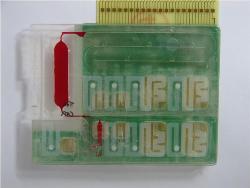Mar 19 2010
Many illnesses can be reliably diagnosed through laboratory tests, but these in vitro analyses often use up valuable time.
 A mini-laboratory for all cases
A mini-laboratory for all cases
A system developed by Fraunhofer research scientists, which can carry out complex analyses on the spot, will soon be ready for the market.
»We’ll just have to wait for the results of the laboratory tests.« These words are familiar to many patients. It then usually takes several days for specimens to be sent to the laboratory and analyzed and for the doctor to receive the results. For many illnesses, however, a speedy diagnosis is crucial if the treatment is to be successful. In future, the patient might only have to sit in the waiting room for a few minutes until the results are ready. In a joint project, researchers from seven Fraunhofer institutes have developed a modular platform for in vitro diagnosis which enables various types of bioanalysis – of blood and saliva for example – to be conducted in the doctor’s surgery. »Thanks to its modular design our IVD platform is so flexible that it can be used for all possible bioanalytical tasks,« states Dr. Eva Ehrentreich-Förster from the Fraunhofer Institute for Biomedical Engineering (IBMT) in Potsdam-Golm.
The core element of the mini-laboratory is a disposable cartridge made of plastic which can be fitted with various types of sensor. For an analysis the doctor fills the cartridge with reagents – binding agents which indicate the presence of certain substances such as antigens in the specimen material. Various tests or assays are available for different types of analysis. To perform an assay, the doctor only has to place the relevant substances in the cartridge and the test then takes place automatically. »We have optimized the assays so that up to 500 assay reactions can be conducted in parallel in a single analysis step,« explains Dr. Ehrentreich-Förster. Even in the case of complex analyses the doctor obtains a result within about 30 minutes. A new module on the reverse side of the cartridge also makes it possible to analyze the specimen material at DNA level.
Once the cartridge has been prepared, the doctor places it in the measurement system. The results can be read out with either optical or electrochemical biosensors. The researchers have installed a readout window for both methods in the measurement system, which features a bypass through which the specimen is pumped.
In addition to medical applications, Dr. Ehrentreich-Förster has other markets in her sights. »The IVD platform is also suitable for food analysis and doping checks.« The mini-laboratory will soon be ready for the market. The scientists are presenting the IVD platform at the Analytica trade show in Munich from March 23 to 26.
Source: http://www.fraunhofer.de